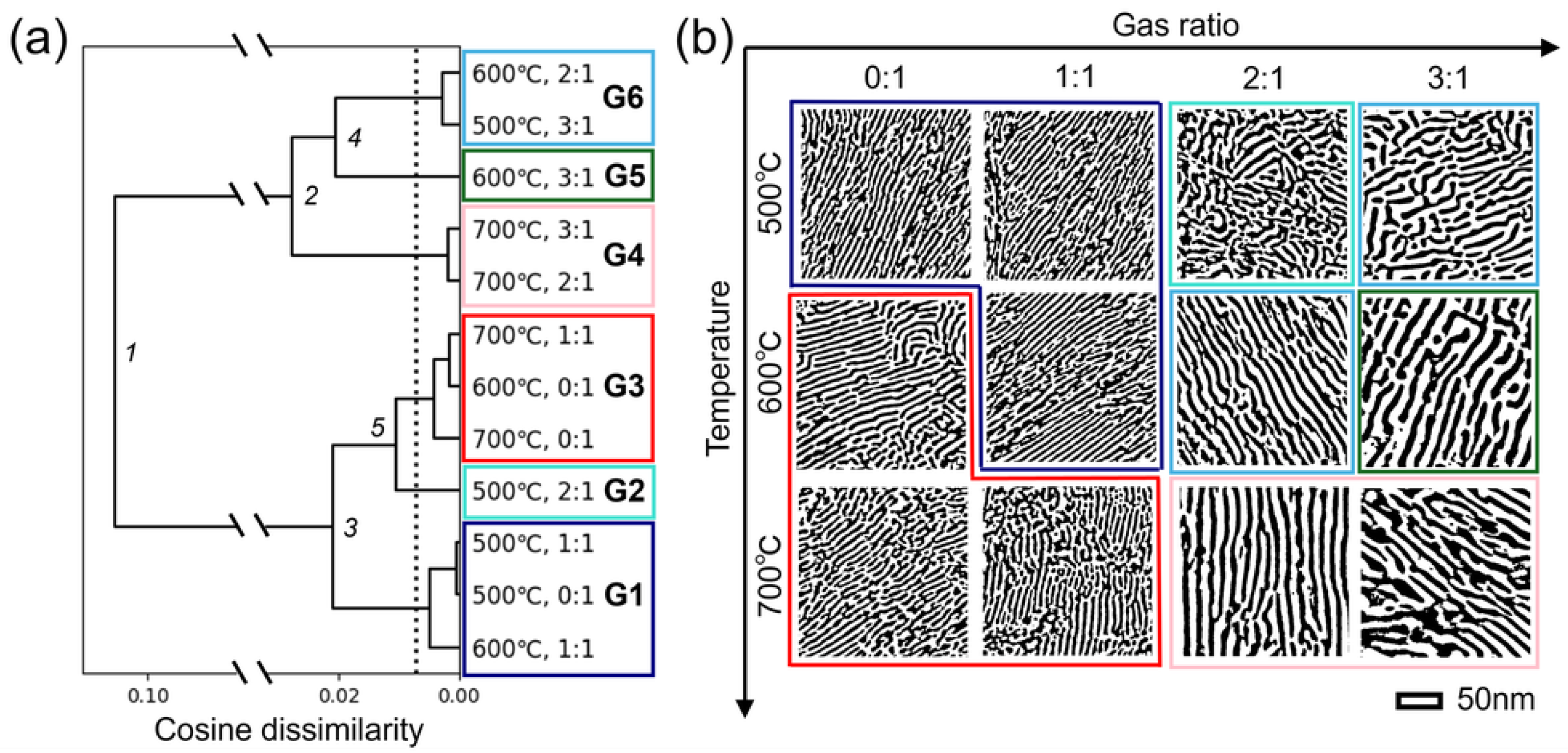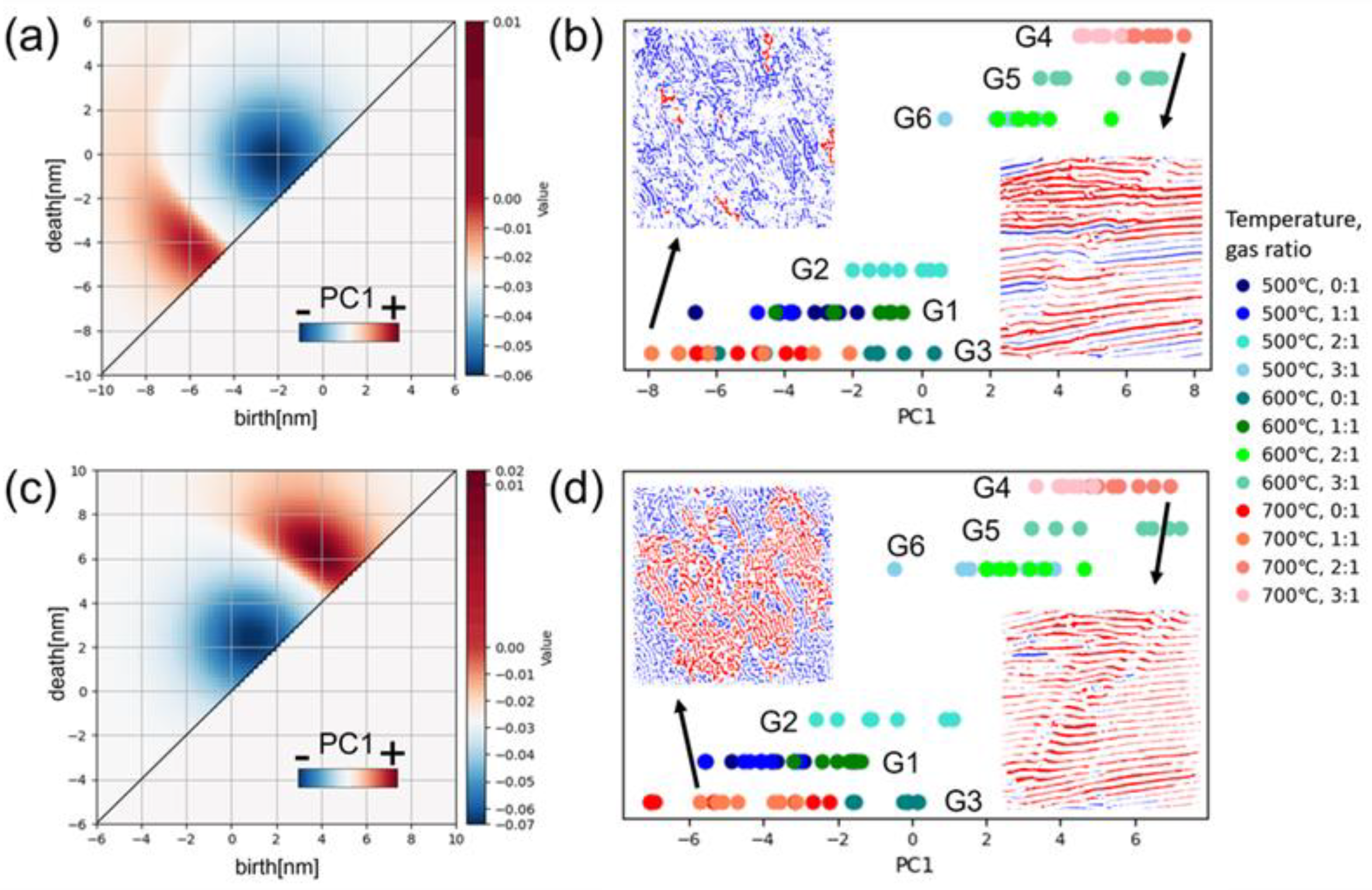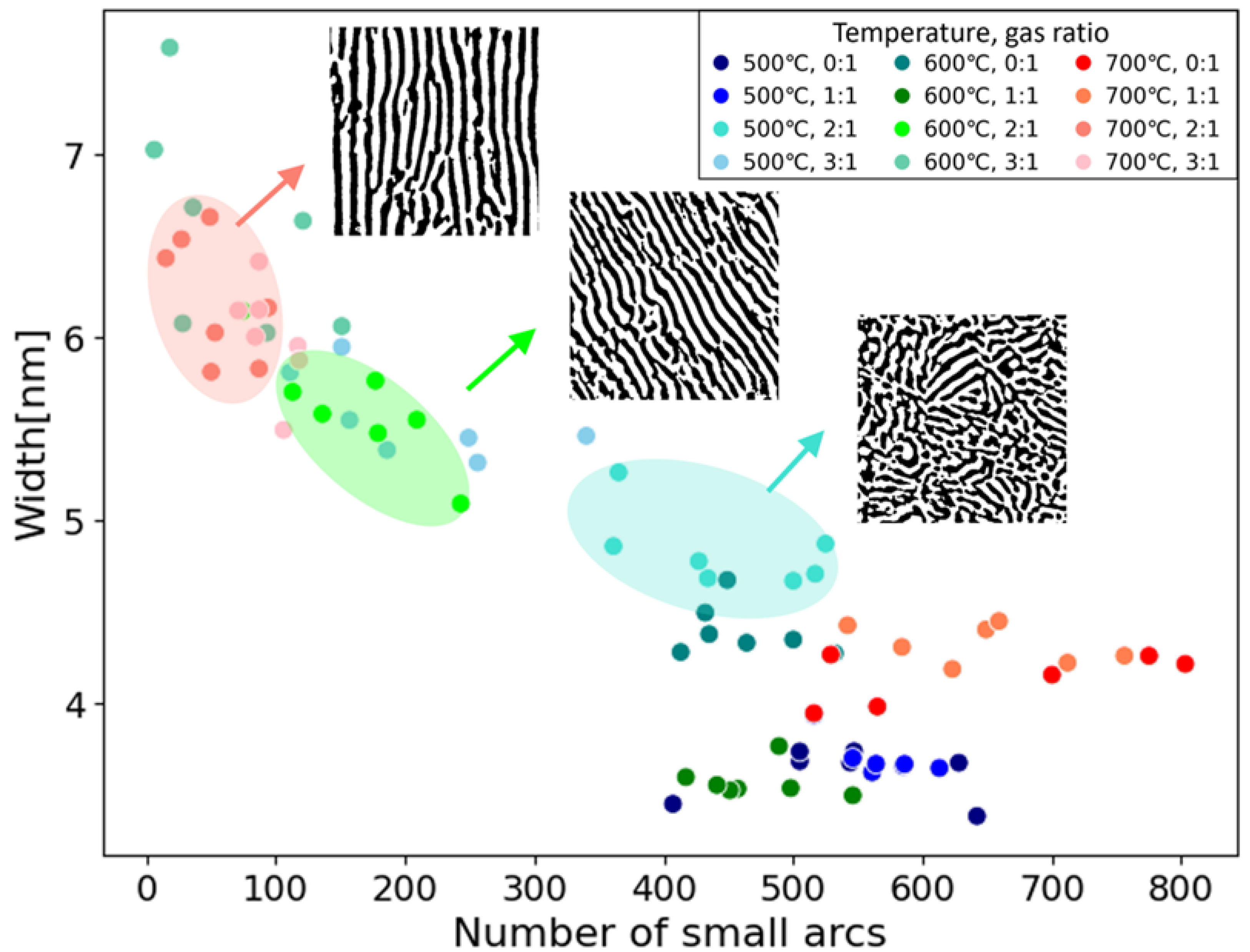Interpretable Structural Evaluation of Metal-Oxide Nanostructures in Scanning Transmission Electron Microscopy (STEM) Images via Persistent Homology
Abstract
:1. Introduction
2. Materials and Methods
3. Results and Discussion
3.1. Extraction of Interpretable Features from Persistent Diagram Quadrants
3.2. Visualization of Interpretable Features by Inverse Analysis of Reconstructed Persistent Diagrams Based on Principal Component Analysis
3.3. Determination and Use of Effective Interpretable Descriptors
4. Conclusions
Supplementary Materials
Author Contributions
Funding
Data Availability Statement
Acknowledgments
Conflicts of Interest
References
- Liu, X.; Iocozzia, J.; Wang, Y.; Cui, X.; Chen, Y.; Zhao, S.; Li, Z.; Lin, Z. Noble metal-metal oxide nanohybrids with tailored nanostructures for efficient solar energy conversion, photocatalysis and environmental remediation. Energy Environ. Sci. 2017, 10, 402–434. [Google Scholar] [CrossRef]
- Jia, Q.; Ghoshal, S.; Li, J.; Liang, W.; Meng, G.; Che, H.; Zhang, S.; Ma, Z.-F.; Mukerjee, S. Metal and Metal Oxide Interactions and Their Catalytic Consequences for Oxygen Reduction Reaction. J. Am. Chem. Soc. 2017, 139, 7893–7903. [Google Scholar] [CrossRef] [PubMed]
- Liu, M.; Weissmuller, J. Phase decomposition in nanoporous Au-Pt. Acta Mater. 2022, 241, 118419. [Google Scholar] [CrossRef]
- Danielis, M.; Felli, A.; Zampol, M.; Fonda, N.; Bruner, P.; Grehl, T.; Furlani, E.; Maschio, S.; Colussi, S.; Trovarelli, A. Tuning Chemical and Morphological Properties of Ceria Nanopowders by Mechanochemistry. ACS Omega 2024, 9, 12046–12059. [Google Scholar] [CrossRef] [PubMed]
- Chen, J.; Yin, H.; Sun, Q. Effects of grain size on fatigue crack growth behaviors of nanocrystalline superelastic NiTi shape memory alloys. Acta Mater. 2020, 195, 141–150. [Google Scholar] [CrossRef]
- Sourav, A.; Yebaji, S.; Thangaraju, S. Structure-property relationships in hot forged AlxCoCrFeNi high entropy alloys. Mater. Sci. Eng. A 2020, 793, 139877. [Google Scholar] [CrossRef]
- Terryn, S.; Brancart, J.; Roels, E.; Verhelle, R.; Safaei, A.; Cuvellier, A.; Vanderborght, B.; Van Assche, G. Structure–Property Relationships of Self-Healing Polymer Networks Based on Reversible Diels–Alder Chemistry. Macromolecules 2022, 55, 5497–5513. [Google Scholar] [CrossRef]
- Ogbonna, N.D.; Dearman, M.; Cho, C.-T.; Bharti, B.; Peters, A.J.; Lawrence, J. Topologically Precise and Discrete Bottlebrush Polymers: Synthesis, Characterization, and Structure-Property Relationships. J. Am. Chem. Soc. Au 2022, 2, 898–905. [Google Scholar] [CrossRef]
- Gad, S.I.; Attia, M.A.; Hassan, M.A.; El-Shafei, A.G. A random microstructure-based model to study the effect of the shape of reinforcement particles on the damage of elastoplastic particulate metal matrix composites. Ceram. Int. 2021, 47, 3444–3461. [Google Scholar] [CrossRef]
- Lykaki, M.; Stefa, S.; Carabineiro, S.A.C.; Soria, M.A.; Madeira, L.M.; Konsolakis, M. Shape Effects of Ceria Nanoparticles on the Water-Gas Shift Performance of CuOx/CeO2 Catalysts. Catalysts 2021, 11, 753. [Google Scholar] [CrossRef]
- Tanaka, H.; Tong, H.; Shi, R.; Russo, J. Revealing key structural features hidden in liquids and glasses. Nat. Rev. Phys. 2019, 1, 333–348. [Google Scholar] [CrossRef]
- Sørensen, S.S.; Du, T.; Biscio, C.A.N.; Fajstrup, L.; Smedskjaer, M.M. Persistent homology: A tool to understand medium-range order glass structure. J. Non-Cryst. Solids X 2022, 16, 100123. [Google Scholar] [CrossRef]
- Benjamin, K.; Mukta, L.; Moryoussef, G.; Uren, C.; Harrington, H.A.; Tillmann, U.; Barbensi, A. Homology of homologous knotted proteins. J. R. Soc. Interface 2023, 20, 20220727. [Google Scholar] [CrossRef] [PubMed]
- Hiraoka, Y.; Nakamura, T.; Hirata, A.; Escolar, E.G.; Matsue, K.; Nishiura, Y. Hierarchical structures of amorphous solids characterized by persistent homology. Proc. Natl. Acad. Sci. USA 2016, 113, 7035–7040. [Google Scholar] [CrossRef]
- Wen, Y.; Hashimoto, A.; Najib, A.S.B.M.; Hirata, A.; Abe, H. Topological Trends in Ionic Transport through Metal-Oxide Composites. Appl. Phys. Lett. 2021, 118, 054102. [Google Scholar] [CrossRef]
- Wen, Y.; Abe, H.; Hirata, A.; Hashimoto, A. Correlation between the Charge-Transport Properties and the 3D-Phase Connectivities in Patterned Pt/CeO2 Nanostructured Composites: Implications for Solid-Oxide Fuel Cells. ACS Appl. Nano Mater. 2021, 4, 13602–13611. [Google Scholar] [CrossRef]
- Hong, S.; Kim, D. Medium-range order in amorphous ices revealed by persistent homology. J. Phys. Condens. Matter 2019, 31, 455403. [Google Scholar] [CrossRef]
- Stellhorn, J.R.; Paulus, B.; Hosokawa, S.; Pilgrim, W.-C.; Boudet, N.; Blanc, N.; Ikemoto, H.; Kohara, S.; Sutou, Y. Structure of amorphous Cu2GeTe3 and the implications for its phase-change properties. Phys. Rev. B 2020, 101, 214110. [Google Scholar] [CrossRef]
- Kunii, S.; Masuzawa, K.; Fogiatto, A.L.; Mitsumata, C.; Kotsugi, M. Casual analysis and visualization of magnetization reversal using feature extended landau free energy. Sci. Rep. 2022, 12, 19892. [Google Scholar] [CrossRef]
- Fogiatto, A.L.; Kunni, S.; Mitsumata, C.; Kotsugi, M. Feature extended energy landscape model for interpreting coercivity mechanism. Commun. Phys. 2022, 5, 277. [Google Scholar] [CrossRef]
- Olsthoorn, B.; Hellsvik, J.; Balatsky, A.V. Finding hidden order in spin models with persistent homology. Phys. Rev. Res. 2020, 2, 043308. [Google Scholar] [CrossRef]
- Minamitani, E.; Shiga, T.; Kashiwagi, M.; Obayashi, I. Topological descriptor of thermal conductivity in amorphous Si. J. Chem. Phys. 2022, 156, 244502. [Google Scholar] [CrossRef]
- Minamitani, E.; Obayashi, I.; Shimizu, K.; Watanabe, S. Persistent homology-based descriptor for machine-learning potential of amorphous structures. J. Chem. Phys. 2023, 159, 084101. [Google Scholar] [CrossRef] [PubMed]
- Sato, R.; Akagi, K.; Takagi, S.; Sau, K.; Kisu, K.; Li, H.; Orimo, S.I. Topological Data analysis of Ion Migration Mechanism. J. Chem. Phys. 2023, 158, 144116. [Google Scholar] [CrossRef]
- Uesugi, F.; Wen, Y.; Hashimoto, A.; Ishii, M. Prediction of nanocomposite properties and process optimization using persistent homology and machine learning. Micron 2024, 183, 103664. [Google Scholar] [CrossRef] [PubMed]
- Adams, H.; Chepushtanova, S.; Emerson, T.; Hanson, E.; Kirby, M.; Motta, F.; Neville, R.; Peterson, C.; Shipman, P.; Ziegelmeier, L. Persistence Images: A Stable Vector Representation of Persistent Homology. J. Mach. Learn. Res. 2017, 18, 1–35. [Google Scholar]
- Yamada, T.; Suzuki, Y.; Mitsumata, C.; Ono, K.; Ueno, T.; Obayashi, I.; Hiraoka, Y.; Kotsugi, M. Visualization of Topological Defect in Labyrinth Magnetic Domain by Using Persistent Homology. J. Vac. Soc. Jpn. 2019, 62, 153–160. [Google Scholar] [CrossRef]
- Sokal, R.R.; Michener, C.D. A statistical method for evaluating systematic relationships. Univ. Kans. Sci. Bull. 1958, 38, 1409–1438. [Google Scholar]
- Pearson, K. On Lines and Planes of Closest Fit to Systems of Points in Space. Lond. Edinb. Dublin Philos. Mag. J. Sci. 1901, 2, 559–572. [Google Scholar] [CrossRef]
- HomCloud (4.4.1). Available online: https://homcloud.dev/index.en.html (accessed on 12 May 2024).
- Obayashi, I.; Nakamura, T.; Hiraoka, Y. Persistent Homology Analysis for Materials Research and Persistent Homology Software: HomCloud. J. Phys. Soc. Jpn. 2022, 91, 091013. [Google Scholar] [CrossRef]
- Breiman, L. Random Forests. Mach. Learn. 2001, 45, 5–32. [Google Scholar] [CrossRef]
- Shudin, N.H.; Eguchi, R.; Fujita, T.; Tokunaga, T.; Hashimoto, A.; Abe, H. Phase textures of metal–oxide nanocomposites self-orchestrated by atomic diffusions through precursor alloys. Phys. Chem. Chem. Phys. 2024, 26, 14103. [Google Scholar] [CrossRef] [PubMed]
- Fabbri, E.; Pergolesi, D.; Traversa, E. Ionic conductivity in oxide heterostructures: The role of interfaces. Sci. Technol. Adv. Mater. 2010, 11, 054503. [Google Scholar] [CrossRef] [PubMed]






| Geometric Information | Representation in PD | 500 °C CeO2 | 500 °C Pt | 600 °C CeO2 | 600 °C Pt | 700 °C CeO2 | 700 °C Pt |
|---|---|---|---|---|---|---|---|
| Number of domains | Number of b-d pairs in positive death region of zeroth PD | 272 (31) | 71 (11) | 158 (18) | 67 (7) | 70 (5) | 68 (9) |
| Width of stripes [nm] | Average of twice the value of absolute birth value in zeroth PD | 4.83 (8) | 5.04 (7) | 5.61 (12) | 6.21 (16) | 6.21 (13) | 6.91 (17) |
| Total length of stripes [nm] | Number of b-d pairs with short lifetime of zeroth PD | 2805 (185) | 3073 (172) | 2458 (245) | 2642 (231) | 1466 (211) | 1473 (217) |
| Number of rings | Number of b-d pairs in negative birth region of first PD | 34 (8) | 186 (29) | 34 (3) | 92 (14) | 25 (7) | 25 (3) |
| Number of arcs | Number of b-d pairs in positive birth region of first PD | 550 (27) | 446 (38) | 390 (27) | 352 (18) | 203 (16) | 193 (16) |
Disclaimer/Publisher’s Note: The statements, opinions and data contained in all publications are solely those of the individual author(s) and contributor(s) and not of MDPI and/or the editor(s). MDPI and/or the editor(s) disclaim responsibility for any injury to people or property resulting from any ideas, methods, instructions or products referred to in the content. |
© 2024 by the authors. Licensee MDPI, Basel, Switzerland. This article is an open access article distributed under the terms and conditions of the Creative Commons Attribution (CC BY) license (https://creativecommons.org/licenses/by/4.0/).
Share and Cite
Eguchi, R.; Wen, Y.; Abe, H.; Hashimoto, A. Interpretable Structural Evaluation of Metal-Oxide Nanostructures in Scanning Transmission Electron Microscopy (STEM) Images via Persistent Homology. Nanomaterials 2024, 14, 1413. https://doi.org/10.3390/nano14171413
Eguchi R, Wen Y, Abe H, Hashimoto A. Interpretable Structural Evaluation of Metal-Oxide Nanostructures in Scanning Transmission Electron Microscopy (STEM) Images via Persistent Homology. Nanomaterials. 2024; 14(17):1413. https://doi.org/10.3390/nano14171413
Chicago/Turabian StyleEguchi, Ryuto, Yu Wen, Hideki Abe, and Ayako Hashimoto. 2024. "Interpretable Structural Evaluation of Metal-Oxide Nanostructures in Scanning Transmission Electron Microscopy (STEM) Images via Persistent Homology" Nanomaterials 14, no. 17: 1413. https://doi.org/10.3390/nano14171413





